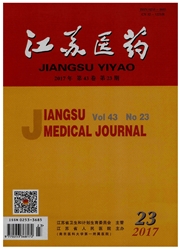

 中文摘要:
中文摘要:
目的评估冠状动脉造影对血压的影响及不同部位有创血压和无创血压监测的临床价值。方法连续人选行冠状动脉造影者128例;其中,经桡动脉路径者31例,经股动脉路径者97例。记录冠状动脉造影前后经桡动脉、股动脉、主动脉根部监测的有创血压和肱动脉水平测量的无创血压。结果在经股动脉路径造影时,术前收缩压监测结果:股动脉压[(163.8±25.1)mmHg]〉中心动脉压[(142.8±24.1)mmHg]〉无创血压[(130.5±22.3)mmHg];舒张压监测结果:中心动脉压[(85.2±12.4)mmHg]〉股动脉压[(81.8±12.0)rainHg]〉无创血压[(77.9±12.1)mmHg]。股动脉造影前后收缩压和舒张压均无显著变化。在经桡动脉路径造影时,术前收缩压监测结果:桡动脉压[(157.2±22.8)mmHg]〉中心动脉压[(144.9±20.8)mmHg-]〉无创血压[(133.2±23.2)mmHg];经桡动脉造影后,中心动脉收缩压较术前显著升高(P〈0.05),但桡动脉收缩压、无创收缩压和舒张压较术前均显著下降(P〈0.05)。结论不同部位有创血压与无创血压监测结果不可相互替代,临床医生应根据不同血压监测结果和患者实际情况对患者进行适当的诊治。
 英文摘要:
英文摘要:
Objective To evaluate the effect of coronary artery angiography(CAG) on blood pressure and the clinical implications of the noninvasive blood pressure and invasive blood pressures monitored from different locations. Methods One hundred and twenty-eight patients received CAG were consecutivelylrecruited in this study. The procedures Were performed through the radial artery in 31 cases and through the femoral artery in 97 cases. Invasive blood pressures were monitored at the levels of radial artery, femoral artery and aorta root, and noninvasive blood pressures were monitored by a sphygmomanometer at the level of brachial artery. Results For the transfemoral artery procedure,the invasive systolic blood pressure(SBP) before CAG was in an order of femoral artery pressure [(163.8±25.1 )mm Hg]〉 center artery pressure[( 142.8 ± 24.1 ) mm Hg] 〉 noninvasive pressure[( 130. 5±22.3) mm Hg]. The diastolic blood pressure(DBP) was in an order of center artery pressure[(85.2±12.4) mm Hg]〉 femoral artery pressure [(81.8 ± 12.0) mm Hg] 〉 noninvasive pressure[(77.9 ± 12.1) mmHg]. Neither SBP nor DBP significantly changed after trans-femoral CAG. For the transradial artery procedure, the invasive SBP before CAG was in an order of radial artery pressure [( 157. 2 ± 22.8) mmHg] 〉 center artery pressure [( 144. 9 ± 20. 8) mmHg]〉noninvasive pressure [(133.2±23.2) mmHg]. After transradial CAG, the center SBP was significantly increased(P〈0. 05), but the systolic radial arterial pressure, systolic noninvasive blood pressure and the diagnostic noninvasive blood pressure were all significantly decreased (P〈0. 05).Conclusion The invasive (monitored at different levels) and noninvasive blood pressures are not interchangeable. Doctors should refer to different blood pressures monitored along with different clinical settings and finally initiate different managements.
 同期刊论文项目
同期刊论文项目
 同项目期刊论文
同项目期刊论文
 期刊信息
期刊信息
